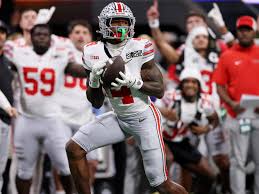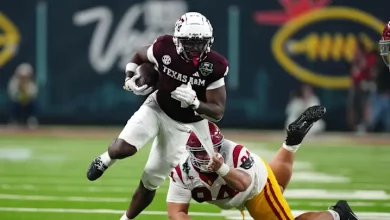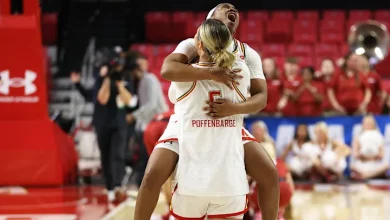Forget loyalty; Jeremiah Smith of Ohio State should use the transfer portal to profit from the national championship.

In the ever-evolving world of college football, where athletes are increasingly empowered by opportunities for personal growth, financial gain, and career advancement, the concept of loyalty has become more complex. One of the most significant developments in recent years is the advent of the NCAA transfer portal, which has allowed student-athletes more freedom than ever before to change programs and seek new opportunities. This freedom has opened up a new realm of possibilities for players like Ohio State’s Jeremiah Smith, a standout wide receiver with tremendous potential. After the Buckeyes’ national championship win, Smith, like many other top-tier athletes, should seriously consider using the transfer portal as a strategic decision—not out of disloyalty, but as a means to capitalize on the opportunity to maximize his earning potential, boost his development, and make the most of his college football career.
While loyalty to a program and its traditions is often lauded, the modern college football landscape has changed significantly. The NIL (Name, Image, and Likeness) deals, the rise of more competitive transfer portals, and the increasing awareness of athletes as independent contractors all play into this new reality. Athletes are now encouraged, more than ever, to make decisions that prioritize their individual interests and long-term career goals. Jeremiah Smith, having proven himself as a top talent at Ohio State, has the ability to leverage these dynamics for his benefit, potentially moving to another program that can provide him with the best opportunities for personal growth, exposure, and financial gain.
Understanding Jeremiah Smith’s Unique Position
Jeremiah Smith entered the college football scene with immense expectations, making an immediate impact as a freshman at Ohio State. As one of the top-ranked wide receivers in the 2024 recruiting class, Smith was heavily recruited by the Buckeyes and immediately became an essential part of their offensive scheme. His speed, hands, and ability to stretch the field gave the Buckeyes a potent weapon at wide receiver, contributing to their national championship run in 2024.
In a season marked by elite competition, Smith emerged as one of the stars of the Ohio State offense, showing maturity and versatility beyond his years. His strong performances during the regular season and in the College Football Playoff demonstrated his ability to compete at the highest level, making him one of the most sought-after wide receivers in the country. His accomplishments on the field, combined with his star potential, mean that he is primed to make a significant impact in the future of college football and beyond.
However, while Ohio State is undeniably one of the top football programs in the country, it’s important to remember that opportunities for success and profit aren’t confined to any one school. The transfer portal has provided athletes with a unique chance to reassess their position, explore new opportunities, and decide whether their current program is the best place for their continued growth, both on and off the field.
For Smith, the question isn’t whether Ohio State can provide him with success—it’s whether other schools can offer him more in terms of exposure, opportunities for higher-profile matchups, or better NIL deals. With the growing power of the transfer portal, athletes have the ability to tailor their college football experience to their needs and ambitions. Smith could make the decision to test those waters, seeking out a program that can provide him with the best possible situation for his future.
NIL Deals: The Financial Incentive
One of the primary motivators for athletes like Smith to use the transfer portal is the significant potential for financial gain through NIL deals. The introduction of NIL rights has changed the landscape of college sports, allowing athletes to profit from their name, image, and likeness in a variety of ways, including through endorsement deals, social media promotions, and merchandise sales. College football players, especially those who possess significant on-field talent and marketability, are now in a position to earn lucrative compensation while still in school.
At Ohio State, Smith has already garnered attention for his performances, but the NIL opportunities available to him could be significantly enhanced by transferring to another program with greater media exposure, higher-profile sponsorships, or a larger fanbase. Programs in high-profile conferences like the SEC or those in major metropolitan areas could provide Smith with access to larger endorsement deals, better visibility, and a stronger platform for his personal brand.
While Ohio State offers its athletes excellent resources, including access to powerful alumni networks and established sponsorships, Smith may find that other programs can offer him a better deal. Schools with large media contracts or football programs with national recognition could give Smith access to more commercial opportunities. Top-tier programs like Alabama, Texas, or USC are known to capitalize on their players’ marketability, providing their athletes with higher-profile endorsements that can significantly enhance their earning potential.
The ability to profit from NIL deals is an important factor in today’s college football landscape, and as one of the most promising young talents in the game, Smith should consider his options. Transferring to a school that can help elevate his personal brand might be a savvy business decision, allowing him to make the most of his college years both on and off the field.
Career Development and Exposure
Another reason for Smith to explore the transfer portal is the opportunity for better career development and exposure. While Ohio State is a prestigious program with a proven track record of developing NFL talent, transferring to a program with a different style of play or a more favorable system could offer Smith a more tailored developmental experience. The goal for any college athlete is to eventually reach the next level—whether that’s the NFL, a professional league abroad, or another high-profile career—but the pathway to success is not always the same for everyone.
Transferring to a program that plays a style of football that better suits Smith’s skillset, or one that is known for developing elite wide receivers, could significantly improve his chances of a successful NFL career. While Ohio State is renowned for producing NFL-caliber wide receivers, the competition for playing time and the specific system in place may not be the perfect fit for Smith’s talents. Some programs may provide him with more opportunities to showcase his abilities, play in a system that highlights his skills, or develop in a way that makes him more attractive to NFL scouts.
Additionally, moving to a different program can offer Smith the chance to play in more nationally televised games or to compete in higher-profile matchups against top-ranked teams. Exposure is a critical component for athletes looking to maximize their chances of going pro, and a strategic transfer could boost Smith’s visibility and improve his draft stock. Whether he’s looking to play in a new conference, face different competition, or gain more media attention, the transfer portal could provide Smith with the chance to tailor his college football experience to his goals for the future.
The Business of College Football: A Player’s Career as a Brand
It’s important to recognize that college football is, in many ways, a business—a business where the athletes, as key contributors, are increasingly seen as independent contractors. College football players like Jeremiah Smith are no longer simply students; they are brands, with potential to generate revenue through their performances on the field, their social media presence, and their personal image. With this in mind, Smith must consider the long-term implications of his decision and whether his current situation at Ohio State provides him with the best platform for growth.
Using the transfer portal is not a move motivated by disloyalty, but rather by a smart, calculated decision to maximize one’s value. Athletes are encouraged to act in their own self-interest, just as any entrepreneur or business owner would. In this context, Smith should view his college football career as a launching pad for future success and carefully consider how to leverage the opportunities available to him. The transfer portal is an invaluable tool that enables athletes to assess their current situation, determine whether they’re in the best position to succeed, and find a program that aligns with their goals.
The Emotional Aspect: Loyalty and Legacy
Of course, loyalty to one’s program and teammates is an important consideration for any athlete. Ohio State has been a significant part of Smith’s development, and the bond he shares with his coaches, teammates, and the fanbase is undoubtedly meaningful. Yet, loyalty is a two-way street. In an era where college football programs are constantly changing, with coaches leaving for better opportunities, recruits transferring in and out, and programs shifting their priorities, it’s important to remember that athletes must look out for their own interests.
Smith’s decision to explore the transfer portal should not be seen as a betrayal of loyalty but as a strategic move in the modern college football landscape. The choices he makes today could have far-reaching consequences for his career and future. If Ohio State continues to be a strong fit for him, then staying with the program could still be a viable option. However, if another program can offer him better opportunities for NIL deals, career development, or exposure, then transferring could be the right choice to maximize his potential.
Maximizing Potential in a New Era of College Football
In today’s college football environment, athletes like Jeremiah Smith have a unique opportunity to shape their futures and careers in ways that were previously unimaginable. The transfer portal, combined with NIL rights, provides them with the ability to make decisions based on their own interests and long-term success. For Smith, leaving Ohio State in search of a better situation—whether it be for financial gain, career development, or exposure—shouldn’t be seen as a betrayal of loyalty but rather a smart, forward-thinking decision in an increasingly competitive and business-driven environment.
The national championship win with Ohio State was a remarkable achievement, but the next chapter of Smith’s career is still unfolding. By using the transfer portal to capitalize on new opportunities, Smith could position himself for an even brighter future, both in college football and beyond. After all, loyalty to oneself and one’s career aspirations should always come first in a game where everything is at stake.









